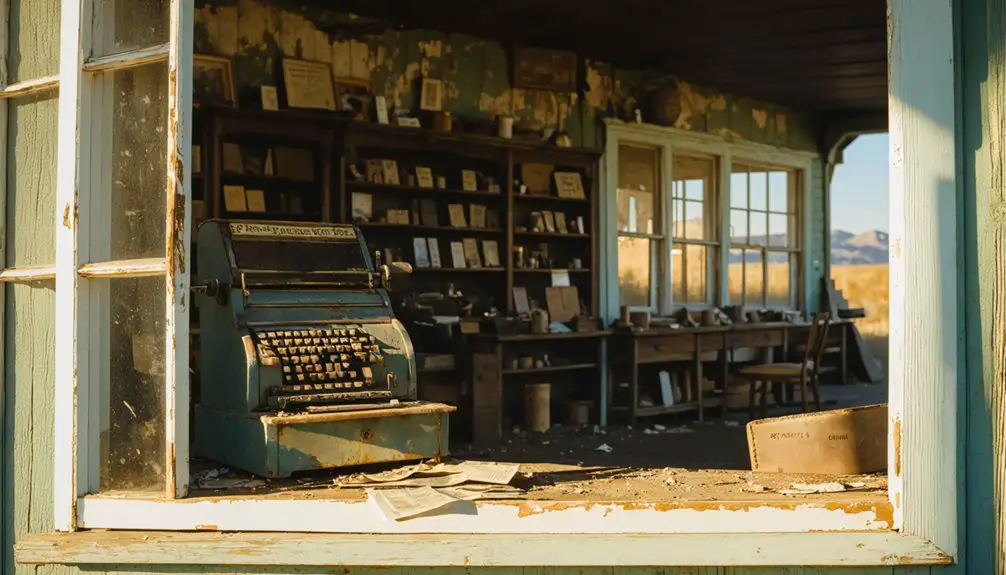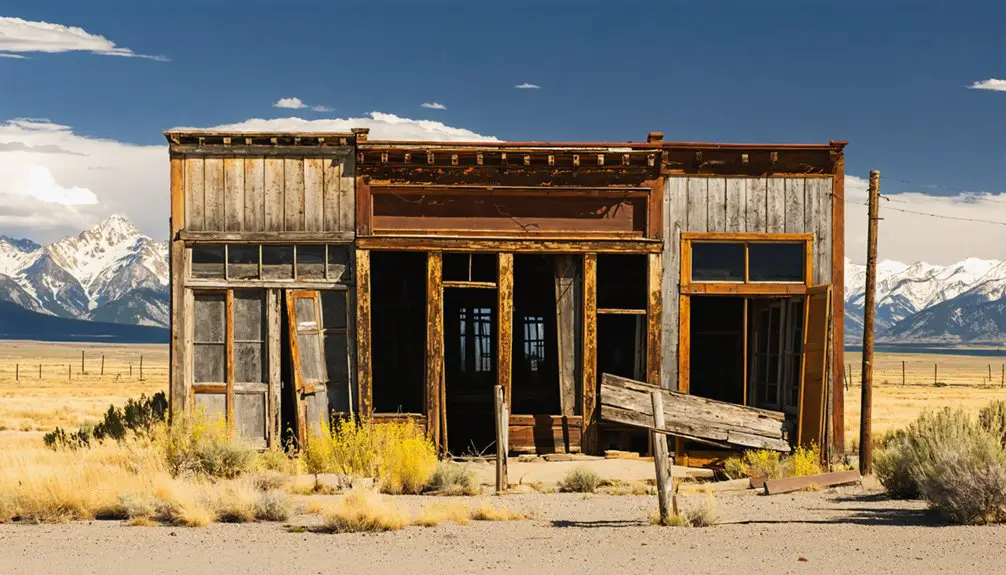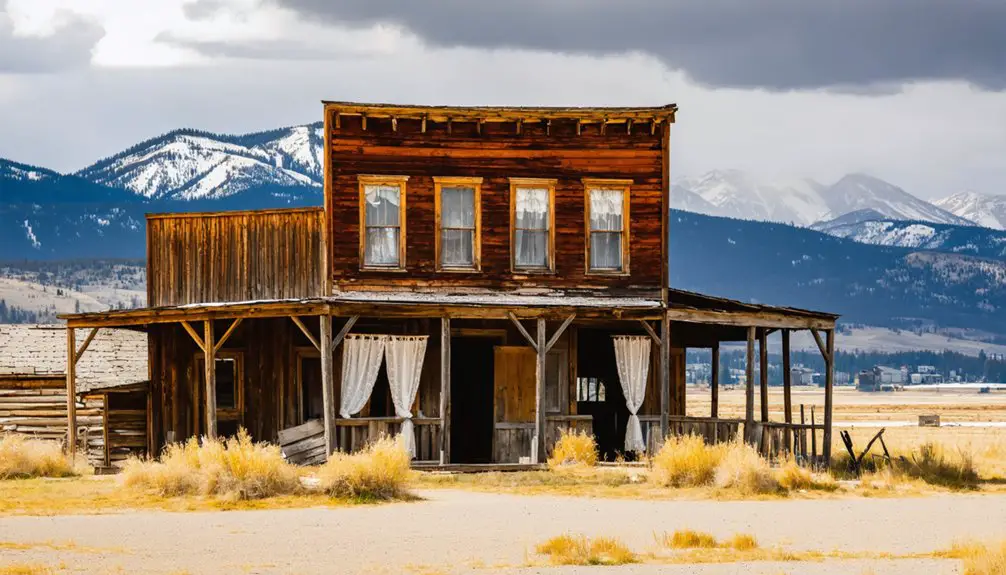You’ll find Sublette, Wyoming’s story traced through its trading post origins in the early 1800s, when William Sublette established it as an essential frontier hub. The town flourished through fur trading, indigenous commerce, and later natural gas exploration, which brought over 1,300 wells by the early 2000s. Today, empty buildings mark where this once-bustling settlement stood, while 23 properties on the National Register of Historic Places preserve its pioneering legacy. The town’s rich layers of history await discovery.
Key Takeaways
- The area experienced a significant economic decline after natural gas production dropped from 1,300 wells to minimal activity in the early 2000s.
- Empty buildings throughout the region stand as remnants of the fossil fuel boom-and-bust cycle that affected the community.
- The region’s history spans from Native American settlements to fur trading posts to modern natural gas exploration.
- Historic preservation efforts protect 23 properties listed on the National Register of Historic Places despite economic challenges.
- The settlement’s transformation from frontier trading post to ghost town reflects Wyoming’s broader pattern of resource-dependent boom-bust cycles.
The Birth of a Frontier Settlement
While the fur trade initially drew adventurous souls like William Lewis Sublette to Wyoming’s rugged terrain in the early 1800s, permanent settlement wouldn’t take root until the turn of the 20th century.
You’d find the first true settlers were hardy English and German immigrants who embraced the frontier lifestyle, carving out homes in this isolated region west of the Wind River Mountains.
Without railroads or major highways, you’d experience the same rugged independence that shaped their character.
The settlement challenges they faced – from harsh weather to mountainous terrain along the Green River valley – forged a self-reliant spirit that defined the area.
The community demonstrated remarkable unity during World War I, with pro-British sentiments guiding their strong support for U.S. involvement in the conflict.
Early settlers focused their ranching operations along major watercourses, taking advantage of the vital resources these areas provided.
Native American Heritage and Early Trading
You’ll find evidence of ancient indigenous life preserved in sites like the Wardell Buffalo Trap and Trapper’s Point, where Native Americans hunted game for over 9,000 years in what would become Sublette County.
The area’s trading posts later emerged as essential hubs where tribes like the Shoshone and Arapaho exchanged furs and knowledge with European trappers, profoundly shaping the region’s early commerce and cultural exchange.
Following traditional seasonal migration patterns, Native peoples moved through the Green River valleys, establishing camps along waterways that would eventually become key trading routes during the fur trade era.
The local economy and culture were significantly influenced by early fur trappers, with William L. Sublette being one of the most prominent explorers who helped establish the area’s trading networks.
Today, visitors can experience this rich heritage through living history demonstrations that showcase authentic mountain man and Native American traditions at local historical sites.
Ancient Hunting Grounds Preserved
Long before Sublette became a ghost town, the region served as essential hunting grounds for indigenous peoples who left behind a rich archaeological legacy spanning over 9,000 years.
You’ll find evidence of their ancient techniques at sites like the Wardell Buffalo Trap, where they used sophisticated bow and arrow methods to hunt buffalo about 1,000 years ago.
The area’s rivers and diverse ecosystem supported massive herds of game, enabling indigenous hunting rituals and seasonal migrations.
Shoshonis, Crows, and Sioux tribes were among the primary native inhabitants who called these lands home.
At Trapper’s Point, you can explore an antelope kill site dating back nearly 8,000 years.
The J. David Love Site holds Wyoming’s oldest burial, revealing the deep spiritual connection natives maintained with these lands.
They’d clear and irrigate areas for sustainable living, practices later adopted by settlers for hay meadows.
An ancient Indian encampment discovered near a stream featured a massive lodge site stretching 150 feet in diameter.
Trading Post Cultural Exchange
As trade networks expanded across the American frontier in the early 1800s, William Sublette established several strategic trading posts along the Missouri River, including the influential Fort William at the junction of the North Platte and Laramie Rivers.
You’ll find that these posts weren’t just places of commerce – they were vibrant centers of cultural exchange between Native Americans and Euro-American traders. The Cheyenne and Sioux tribes would camp near the forts seasonally, trading buffalo robes for goods like tobacco, blankets, and beads. Ashley’s Hundred was recruited in 1823 to help establish this new fur trading strategy and compete against British-Canadian companies. The post was strategically positioned to help Sublette control central trade through his network of trading locations.
Native trading practices greatly influenced how business was conducted, creating a unique blend of customs and commercial methods. While this exchange brought mutual economic benefits, it also introduced challenges through items like alcohol, which impacted traditional Native American social structures and health patterns.
Indigenous Seasonal Migration Routes
The Eastern Shoshone‘s intimate knowledge of Wyoming’s landscape shaped their sophisticated network of seasonal migration routes, which they traversed between 1825 and 1875.
You’ll find their Indigenous trails marked by stone cairns and natural landmarks, leading from winter lowlands to summer highlands near places like Willow Lake.
These seasonal migrations weren’t random wanderings – they strategically followed game animals like elk, mule deer, and pronghorn, which moved up to 150 miles seeking nutritious vegetation. Indigenous peoples tracked the herds as they moved to lower elevations in autumn.
The Shoshone’s paths through South Pass and the Wind River Range later influenced major transportation corridors you know today. Fur trappers and early explorers like the Astorians relied heavily on these established routes.
Within the Wind River Indian Reservation, mule deer still follow ancient migration routes spanning up to 131 miles, a reflection of the enduring wisdom of Indigenous trail networks.
Life in Early Sublette
Early settlers in Sublette faced three major challenges: harsh winters, isolation, and the need to establish sustainable agriculture.
You’ll find their pioneer struggles reflected in the adaptations they made, from transforming sagebrush into hay meadows to developing intricate irrigation systems.
Community resilience emerged through shared resources and cooperation, despite the scattered nature of settlements.
- You’d have attended religious services in multi-purpose buildings with traveling ministers
- Your cattle would’ve grazed east of the Green River in winter, moving west for summer
- You’d have joined fellow ranchers in clearing sagebrush and digging irrigation ditches
- Your social life would’ve centered around seasonal events and trade gatherings
- You’d have worked alongside English and German immigrants, maintaining relatively harmonious relationships despite global tensions
The Economic Rise and Fall

You’ll find Sublette’s early economic story centered around its bustling coal mines and fur trading operations, which employed dozens of locals and drove the town’s initial prosperity.
The town’s fortunes peaked in the early 1900s when lot prices soared and amenities like mercantile stores, bars, and hotels flourished alongside profitable ventures such as dude ranches and hunting lodges.
Trading Post Prosperity
During the economic heyday of Wyoming’s frontier era, William Sublette‘s shrewd business sense transformed a simple fur trading venture into a prosperous commercial empire.
By understanding trading post economics and fur trade dynamics, he built Fort William near South Pass, creating a crucial hub for westward expansion.
- Strategic positioning at the last eastern stream crossing made Fort William essential for wagon routes
- Trading operations adapted as beaver populations declined, shifting from trapping to trading
- Peak fur trade years of the 1820s-1840s centered around the Green River Valley
- Competition drove the establishment of permanent trading posts for regional control
Fort William’s success led to its acquisition by the American Fur Company, later becoming Fort John and eventually Fort Laramie.
Boom to Ghost Town
As natural gas exploration transformed Sublette County in the late 1990s, a dramatic economic boom took root that would ultimately lead to the area’s decline.
You’d have witnessed an explosion of growth as natural gas wells multiplied from just 58 in 1997 to over 1,300 in the early 2000s, bringing unprecedented wealth to the region.
Like many Wyoming boomtowns before it, Sublette’s lack of economic diversification proved fatal.
While the fossil fuel revenue funded new schools and infrastructure, it also created an unsustainable dependence on a single industry.
When drilling activity slowed, the community’s resilience was tested as workers fled and public services struggled.
Today, empty buildings stand as stark reminders of the boom years, echoing the fate of uranium towns like Jeffrey City that lost over 90% of their population.
Daily Pioneer Life and Social Activities
Life in Sublette’s pioneer settlements revolved around a demanding daily routine of manual labor and self-sufficiency. You’d have spent your days drawing water from wells, chopping firewood, and tending to home gardens for survival.
Pioneer entertainment centered around the dance hall, where community gatherings brought relief from the isolation of frontier living. Trading posts served as social hubs, while church services unified settlers during trying times.
- You’d have lived in simple log cabins heated by wood-burning stoves during harsh Wyoming winters.
- Your social life would’ve intertwined with seasonal celebrations and holiday events.
- You’d have relied on cooperation with neighbors and indigenous tribes for trade and survival.
- Your medical care would’ve depended on traveling doctors or home remedies.
- You’d have found entertainment through community dances and gatherings at places like trading posts.
Natural Resources and Development

The rich natural resources of Sublette’s territory shaped its economic evolution through distinct phases of development.
You’ll find evidence of indigenous peoples’ presence dating back 9,000 years, with ancient kill and burial sites marking their seasonal hunting grounds.
The region’s resource exploitation began with the fur trade, as trappers like William Sublette established trading posts along the Green and New Fork Rivers.
When fur trading declined, the area underwent an economic shift to ranching and cattle operations. The Upper Green River Valley and Hoback Basin provided ideal summer grazing lands, while mineral prospecting attracted miners to the region.
Though mining never dominated Sublette’s economy like nearby areas, the combination of waterways, grasslands, and wildlife continued supporting the shift toward sustainable ranching operations.
Legacy of the Ghost Town
Shadows of a once-thriving frontier community linger in Sublette’s remaining log structures and historic sites, telling stories of perseverance and eventual decline.
You’ll discover a rich cultural significance woven into the fabric of this ghost town, from its early fur trading roots to its days as an essential stop along the Oregon Trail. The community’s resilience shines through its preserved buildings and enduring folklore.
Abandoned structures whisper tales of pioneers and traders who carved out a rugged existence along this historic western passage.
- Danish immigrants established nearby New Fork in 1888, creating an important trading hub
- Archaeological evidence reveals over 7,000 years of human presence in the area
- The Valhalla dance hall once hosted vibrant social gatherings despite frontier isolation
- Local urban legends and ghost stories keep the town’s memory alive
- Preserved structures stand as a symbol of Wyoming’s frontier heritage
Architectural Remnants Today
Standing as silent witnesses to Sublette’s past, weathered architectural remnants offer glimpses into this frontier settlement’s structural heritage.
You’ll find the town jail dominating the landscape, its thick stone walls displaying remarkable structural resilience against time’s relentless march. While architectural decay has claimed most roofs and weakened many walls, you can still trace the town’s layout through scattered foundations and partial structures.
As you explore the site, you’ll discover remnants of cellars and utility buildings that once served the community’s daily needs. The jail’s robust masonry construction stands in stark contrast to the deteriorating wooden frames of surrounding buildings.
Throughout the site, these surviving elements tell the story of a practical frontier town, where function trumped form in the harsh Wyoming environment.
Historical Preservation Efforts
Preservation initiatives for Sublette’s historic sites gained momentum in 1921 when Wyoming Rep. P.W. Jenkins introduced House Bill 17 to establish Sublette County.
Today, you’ll find dedicated community members working to protect these invaluable pieces of Wyoming’s heritage, despite significant preservation challenges like harsh weather and limited funding.
Local preservationists fight an uphill battle against time and elements to safeguard Wyoming’s precious historical landmarks for tomorrow.
- Local historians Dean Sherman and Arvid Aase actively document and champion ghost town preservation
- 23 properties within Sublette County are listed on the National Register of Historic Places
- Community engagement includes educational tours and informational displays at historic sites
- Natural decay and remote locations create ongoing maintenance difficulties
- Grassroots preservation efforts focus on preventing historic structure loss while promoting cultural tourism
These preservation initiatives help guarantee that future generations can experience Sublette’s rich pioneer history firsthand.
Frequently Asked Questions
Are There Any Reported Ghost Sightings or Paranormal Activities in Sublette?
You won’t find documented ghostly encounters or official paranormal investigations here. Despite its ghost town status, there’s no verified evidence of supernatural activity in this abandoned settlement.
What Happened to the Original Town Records and Documents?
You won’t find the original town records today – they’re missing due to fires, riots, and abandonment. Without historical preservation efforts, these archives were lost to natural decay and deliberate destruction.
Can Visitors Legally Explore or Metal Detect in Sublette Today?
You can’t legally metal detect without special permits due to strict legal regulations. Visitor guidelines require written authorization from state agencies for any exploration of protected historic sites.
Were There Any Notable Crimes or Outlaws Associated With Sublette?
You won’t find many documented outlaw history or crime reports from Sublette, though it had a jail. While frontier lawlessness existed regionally, no notorious criminals specifically terrorized this trading post.
Did Any Famous Historical Figures Ever Pass Through Sublette?
While famous travelers likely used the Oregon Trail’s Sublette Cutoff nearby, you won’t find records of any notable historical figures specifically visiting this ghost town or its historical landmarks.
References
- https://www.wylr.net/2021/10/01/sublette-county-history-residents-take-pride-in-the-past-present-and-future-of-beef-production/
- https://www.wyohistory.org/encyclopedia/sublette-county-wyoming
- https://en.wikipedia.org/wiki/New_Fork
- https://wyomingwhispers.com/sublette-wy-ghost-town/
- https://www.youtube.com/watch?v=85n7a7qCQ44
- https://en.wikipedia.org/wiki/Sublette_County
- https://oregontrailgenealogy.com/mystery-of-the-sublette-millions/
- https://mymcpl.bibliocommons.com/item/show/3506883110
- https://wyomingdigitalcollections.ptfs.com/aw-server/rest/product/purl/WSL/i/b7d5f3f5-049f-4743-a63a-244d78df88e1
- https://www.visitsublettecounty.org/history



